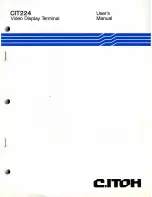
page 60 008-0671-00
10.5.4
CALIBRATION
TYPE
Menu Item
This chooses the type of calibration technique to be used. There are three methods
that can be used to calibrate the transducer to the Input Channel. Each has advan-
tages and disadvantages as described in the table below.
It is important to know your application
in order to select the appropriate calibration
type. mV/V (“millivolt-per-volt”) Calibration is recommended for most applications
because it doesn’t require known loads and it allows easy swapping of transducers
equipped with
Signature Calibration
. When the best possible accuracy is required,
Known-Load Calibration is recommended.
The choices for this menu item are:
•
“
TYPE= SHUNT CAL
” means Shunt Calibration. First, you are prompted to apply the
load entered in the “
ZERO SCALE VALUE
” register. Next, the instrument inserts a
known, precision resistor into the transducer circuit, which causes a predictable
apparent signal. The instrument then takes a reading and adjusts itself using the
Table 4-9: Comparison of Calibration Types
Shunt
Calibration
mV/V
Calibration
2-, 3-, or 5-
point
Known Load
Calibration
RECOMMENDED...
...for most applications
no
yes
no
...when frequently swapping
transducers
yes
yes
no
...when best possible accuracy
required
no
no
yes
PROS and CONS
Relative accuracy
good
better
best
Requires actual, calibrated loads
to be applied
no
no
yes
Automatically calibrates with
Sig-
nature Calibration
transducers
yes
yes
no
Max. distance of transducer from
instrument
15’ [5m]
50’ [15m]
300’ [100m]
CALIBRATION TECHNIQUE
Zero-scale point from...
applied load
applied load
applied load
Full-scale point from... transducer
output when
shunt resistor
applied
internal
reference
applied load
Linearity correction from...
data stored in
Signature
Module
(if
available)
data stored in
Signature
Module
(if
available)
2-point: none
3- or 5-point:
applied load
Summary of Contents for SC500
Page 8: ...page 8 008 0671 00 ...
Page 14: ...page 14 008 0671 00 ...
Page 18: ...page 18 008 0671 00 ...
Page 24: ...page 24 008 0671 00 ...
Page 38: ...page 38 008 0671 00 ...
Page 42: ...page 42 008 0671 00 ...
Page 50: ...page 50 008 0671 00 ...
Page 72: ...page 72 008 0671 00 ...
Page 82: ...page 82 008 0671 00 ...
Page 90: ...page 90 008 0671 00 ...
Page 116: ...page 116 008 0671 00 ...
Page 126: ...page 126 008 0671 00 ...
















































